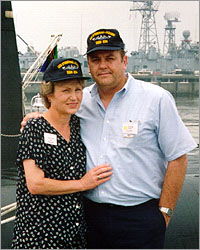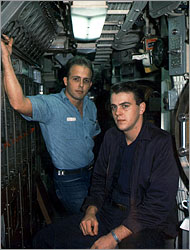
|
 |
 |
(back to Life on a Submarine) I was a member of the commissioning crew on the USS Stonewall Jackson (SSBN-634) at Mare Island Naval Shipyard from January 1964 through May 1965. In addition to the new construction, shakedown cruise, and missile firings at Cape Canaveral, I rode the Stoney J on five patrols. They called them "deterrent patrols" in more politically sensitive times, but they were in fact war patrols. We were loaded and ready for war. This was during the early years of Secretary of Defense Robert S. McNamara's "Mutually Assured Destruction" or MAD policy, and Polaris was a "city killer," designed to lay waste to cities and civilizations in retaliation for a first strike from a Communist country on the U.S. or our allies. We didn't know whether the next "Flash" message would be a drill or the end of the world. I was on patrol when the Six-Day War between Israel and Egypt broke out, and we thought, "This is It...." We stood ready to destroy the world, as we knew it, in order to save it from Communism. It was a time of collective paranoia and hysteria, and we all came far too close to that threshold of annihilation.
The submarine service taught me how to lead and how to follow. The "school of the boat" taught me what I call the three A's—adaptability, attitude, and accountability. These gave me the confidence and knowledge to manage any situation life or the sea could throw my way. These were skills I have used every day of my civilian life, in my marriage, and in my career. I earned my Dolphins after a year of learning how to get along and work at whatever needed to be done and for as long as it took to do it. And those Dolphins, they leave marks on your chest, right over your heart, long after the uniforms have been put away. Once you have earned them, you will always wear them, and you will always be recognized as a submariner by the submarine community. —Bud Turner, now of Vacaville, California, spent six years in the submarine service, from 1962 to 1968. In 1994, he rode the USS Stonewall Jackson on its final voyage, from San Diego, California, to Bremerton, Washington, where it was decommissioned and scrapped under the Submarine Recycling Program. He is currently writing a book about the Fleet Ballistic Missile submarine service. Continue: Dave Henry
See Inside a Submarine | Can I Borrow Your Sub? Sounds Underwater | Life on a Submarine Resources | Transcript | Site Map | Submarines Home Editor's Picks | Previous Sites | Join Us/E-mail | TV/Web Schedule | About NOVA Watch NOVAs online | Teachers | Site Map | Shop | Search | To Print PBS Online | NOVA Online | WGBH © | Updated May 2002 |
 Bud Turner with wife Mary.
Bud Turner with wife Mary.
 Bud Turner (right) and Val Robichaux on watch aboard
the USS Stonewall Jackson.
Bud Turner (right) and Val Robichaux on watch aboard
the USS Stonewall Jackson.